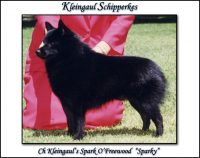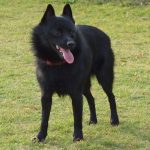 The Black Schipperke is a small dog breed standing no higher than thirteen inches. These small dogs are extremely active and energetic and like to stay busy. They require daily walks of twenty to forty minutes a day and enjoy playing and exploring. Their prey drive and need to explore results in the necessity or training them early to come when called. The inherent prey drive also means that this breed should be kept away from rodents, lizards, and birds.
The Black Schipperke is a small dog breed standing no higher than thirteen inches. These small dogs are extremely active and energetic and like to stay busy. They require daily walks of twenty to forty minutes a day and enjoy playing and exploring. Their prey drive and need to explore results in the necessity or training them early to come when called. The inherent prey drive also means that this breed should be kept away from rodents, lizards, and birds.
In the 1960s these small dogs became popular dogs to have on Flemish barges. They were given the name Schipperke which means “little captain” in Flemish. The Black Schipperke was brought to America in 1888 by Walter J. Comstock. The breed was recognized by the American Kennel Club in 1904.
Originally bred to be companions as well as watchdogs and rat hunters, the Black Schipperke has a small but thickset body type. The breed developed a cat-like stealthy hunting style over time. Their black coat is thick around the neck, shoulders, and legs which gives the breed a sturdy look. They are normally moderate shedders, but they do lose their entire undercoat twice a year.
This breed has no tail and has a very distinctive fox-like face. Males usually stand between eleven and thirteen inches tall while females only measure ten to twelve inches in height. The breed usually weighs between ten and sixteen pounds. Their life expectancy is twelve to fourteen years.
Their personalities tend to be curious and confident and they are always alert due to their breeding as watchdogs. This breed can be mischievous and behave better when supervised while around children. Their barking needs to be controlled with training because it can become a problem if they are not properly trained. Since the breed was originally meant to be a companion dog, they do not do well when left alone for long periods of time. These little dogs need to spend a large amount of their time interacting with humans and they prefer being with their owners.
For a novice owner, this breed may be a challenge to train because they are smart and quite stubborn. Their brains and speed can be utilized in training for agility as well as flyball, obedience, and rally dog sports. This will provide them with physical and mental challenges and deter them from digging and other destructive behavior they may display when bored and lonely. This is an alert and active breed in need of physical and mental challenges to keep them busy.
Black Schipperkes also need a securely fenced yard and to be on a leash when outside the fence. An underground electronic fence may not stop this breed when they are tracking a small furry creature like a rabbit or a squirrel. Training sessions for these little dogs need to be short and reward based. The breed is known for its intelligence and they may interpret your commands in their own way without constant positive reinforcement with food or praise.
Socializing puppies at an early age is extremely important. This is a breed who is intensely attached to its human family but can be wary of strangers. Inviting people into your home while your puppy is young is important to help them learn to accept strangers. Puppy training classes can also be extremely helpful when working with this stubborn breed. Most classes require that vaccines be up to date before you enroll your puppy but you can work with them at home as early as eight weeks old. Owners who wait until their puppy is six months old or older to begin training have a much more headstrong dog to work with.
Overall, the Black Schipperke is an active, alert, loving breed who want to be companions. They are good watchdogs but can be a challenge for a novice owner to train. They require secure fencing or leashes to keep their desire to explore from getting them into trouble. They can make excellent dogs for the right owner.







